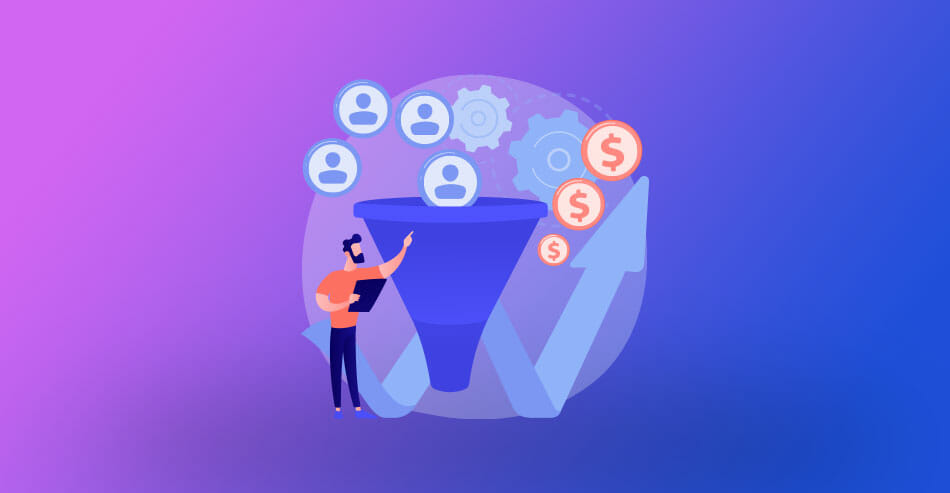Conversion Rate Formula
| Conversion rate = (Conversions ÷ Interactions) ✕ 100 |
What is a Good eCommerce Conversion Rate?
Although the median conversion rate for eCommerce digital properties is 5.2%, you shouldn’t expect your site to achieve this metric immediately unless it is already among the best-performing in the sector. A good conversion rate for sites, apps, and other properties in this sector is typically between 2 and 5%, with rates exceeding 5% considered high-performing.
Remember that your particular business may want to target a higher or lower conversion rate depending on other factors than the sector. For example, the type of products sold can affect your expected conversion rates. If your eCommerce store or website primarily sells niche or specialized products, your conversion rates may be lower than a generalist platform.
How to Calculate Conversion Rate
Knowing the know-how of calculating conversion rate is essential in any marketing strategy, even if your conversions and business objectives aren’t about increasing sales and revenue. There are multiple methods to define conversions, and learn how to calculate your conversion rate based on your conversion goals.
How to Boost Your Conversion Rate
Regardless of your industry, target audience, or business objectives, applying the best available methods to make user interactions and boost conversions while gaining new unique visitors, is essential to ensure the highest number of users and visitors complete the tasks that matter and become converts.
1. A/B Testing
Testing any planned changes before implementation is crucial to ensure they work as intended. A/B testing involves two versions of your digital property: Version A, the current version, and Version B, which features any changes you’ve made to boost the conversion rate. A/B split testing lets you directly compare both versions’ performance before implementation, ensuring you retain only the most efficient modifications.
2. Headline Optimization
The headlines of landing pages are the first thing viewers see when they visit your site and its digital properties. Optimizing them with short, highly descriptive copy and relevant keywords is a cost-effective method to boost your conversion rates.
3. Refined Audience Targeting
Analytics tools on mobile devices and software can provide you with crucial information and insights on engagement metrics, such as the consumer profile of your conversions. Understanding your audience better helps you improve your targeting and attract more visitors with a similar profile.
4. Keyword Optimization
Optimizing keywords for conversion rates is called Conversion Rate Optimization (CRO). Using keyword research tools such as Google Keyword Planner or the keyword tool in Google Ads Reports can help you find the best high-conversion keywords for your sector.
Developing Your Offer with a Robust Conversion Funnel
One of the most efficient methods of ensuring higher conversion rates is developing your offer and creating a process that encourages users and visitors to complete the desired task. Whether you want to encourage regular website visitors to become paying customers or get new visitors, new registered members, or subscribers, this process is known as the conversion funnel.
A sales funnel is comprised of four stages whose end goal is for visitors to convert. Each stage brings a visitor closer to becoming a convert:
- Awareness: A visitor becomes aware of your product, brand, or service through advertising, social media posts, or word-of-mouth. Building robust ad campaigns can improve visitor awareness of your brand, helping make more people aware of your platform.
- Interest: Once a visitor knows of your brand, the next stage is to get them interested. Visitors will compare your offerings with their needs and problems to determine whether you offer the best solution. The most reliable way to increase interest is to use audience analytics tools to understand your visitors better and ensure your products and services match their needs.
- Decision: Although many visitors may be interested in your product, interest doesn’t necessarily guarantee a conversion. At this stage, they will look into the conditions. For example, when trying to secure a sale, potential customers at this stage will pay close attention to deals, pricing, and packages. Ensuring your conditions are as clearly defined as possible is crucial to bringing them to the next stage.
- Action: The final stage is whether or not a visitor decides to complete the task necessary to convert. Making the conversion process as easy and convenient as possible is critical. Overly complex conversion processes can instead drive visitors away and make them reconsider at the last moment.
Enhance Your Digital Properties with CodeFuel
While adopting the right strategies to get more website traffic and boost your conversion rates and obtain maximum ROI is necessary to ensure your business’s success, it can sometimes be challenging without expert assistance. CodeFuel’s team of digital marketing experts can help you analyze your business goals and find the best strategies to increase your website’s organic traffic and conversion rates. Contact us today to get started.
Maximize your revenue with Codefuel. Earn more conversions
[ad_2]
